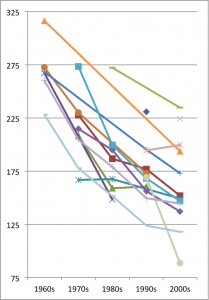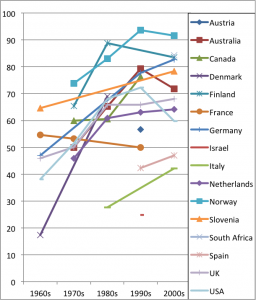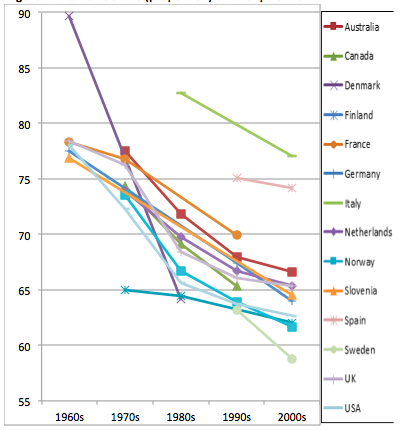Despite substantial increases in married mothers’ employment and the expressed desire of the majority of women and men to share employment and caregiving responsibilities, gender remains the most influential determinant of who does the housework and child care today. Many observers have attributed the seeming unwillingness of men to increase their time in housework and child care as the linchpin of gender inequality, a manifestation of men’s patriarchal power to prioritize activities that provide economic rewards, such as paid work, or enjoyment, such as leisure (Goode 1992; Jackman 1994).
One strain of feminist and academic scholarship holds that men feel no need to do more child care or housework because they reap the benefits of marriage and fatherhood (e.g. marriage and fatherhood wage premiums, living in a clean, well-run household, and children’s performance of filial duties) without having to spend time producing them — cooking, cleaning, or taking on the everyday, physical care of children. Rather, they can expect wives and mothers to shoulder the burden of feeding and caring for children and families, regardless of women’s other time demands. Such an analysis builds on the work of Jessie Bernard, an influential feminist sociologist, who argued that marriage is a gendered institution that privileges men and disadvantages women.
One key assumption of this argument has been that men do not want to become involved with children except when they can have fun with them. But this argument does not hold up when we analyze both the quantitative time diary data on mothers’ and fathers’ child care time and the qualitative literature on what fathers want. Instead, careful examination reveals a more complex story about the interplay between gender, marriage, parenthood, and class-differentiated patterns of childrearing that are more about ensuring upward mobility among children than about gender oppression.
Trends in housework and child care based on time diary data.
Analysis of time diary data on household and care work in the United States from 1965 to 2012 indicates that women’s and men’s housework and child care are much more similar today than they were fifty years ago. This greater gender similarity has been achieved through two main routes. First, there has been a steep reduction in women’s housework, along with a more modest increase in men’s housework, though with much less change occurring after 1985. Second, both mothers and fathers have increased the time they spend caring for children, resulting in diminished though still substantial gender differences in child care time and activities.
Specifically, women’s daily housework dropped by one hour and 45 minutes between 1965 and 2012, falling from four hours a day to less than two-and-a half hours a day. Only 19 minutes of the decrease occurred after 1985. Men’s housework tripled, after starting from a much lower base, rising from only 36 minutes in 1965 to one hour and 40 minutes in 1998. Some evidence indicates that after 1998 it then decreased by about 20 minutes (to one hour and 23 minutes) by 2012. However, this dip may result simply from the smaller sample size in 1998, compared to data from the 2000s, and methodological differences in the surveys. The 2004 and 2012 data were based on much larger samples (about 14,000 women and men), and were part of an annual, nationally representative survey collected by expert interviewers at the Bureau of Labor Statistics. The 1998 data were based on only about 1,000 women and men, although they were still nationally representative. Despite this finding, which may or may not result from an actual stall, the data point to substantial increases in men’s housework since 1965.
It is particularly important to note that the increases in men’s domestic work come primarily from increases in core household tasks, such as cooking and cleaning. In 1965, men reported only 16 minutes a day of core housework; in 2012, they reported 40 more minutes, with half of the increase coming from daily cleaning. This suggests that the changes are not simply the result of men taking on more of the discretional or enjoyable jobs. Men’s core housework remains lower than women’s, but because men continue to have longer employment hours than women, this might be because men have less time available for housework each day.
Slightly fewer women today than in the past report doing housework on the diary day they are asked to record in time-use studies (88 percent in 2012 compared with 96 percent in 1965), and those who do housework report spending less time at it, suggesting a broad disinvestment of women in cooking, cleaning and other household work. In contrast, significantly more men report housework on the diary day: about 70 percent since 1985, up from just barely half in 1975 and 1965. In sum, gender differences in housework have diminished considerably, with fewer women and more men doing the daily housework today than in earlier decades. In 1965 married mothers reported doing a staggering 22 times as much cooking, cleaning and laundry as married fathers; today the comparable ratio is 3.4.
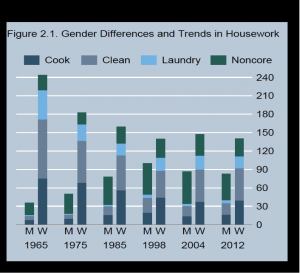
That’s the glass half-full story. The glass half-empty story emphasizes the continued gendered disparities in housework. Women still did 1.7 times men’s housework in 2012, compared with 6.8 times in 1965. This is progress, but why haven’t we seen more change?
Comparisons of housework by marital, parental, and employment status offer some clues.
One would think that single women and men without children would have similar levels of housework, because they aren’t living in the same household with a partner or children. This reduces the demand for cooking, cleaning, and laundry, meaning that individual standards of cleanliness may be a bigger determinant of housework then the more inflexible demands of family life.
Yet time diary data show that in 2012 single women with no children reported doing almost twice as much cooking, cleaning, and laundry as single men with no children. This is lower than the ratio in 1965, when single women with no children were doing about five times as much core housework. And single women and men have more similar patterns than with married parents, where mothers report doing almost four times as much core housework as married fathers. Nevertheless, there is still a substantial difference in household workloads between single, childless men and women, and it is not one that can plausibly be explained by men’s exercise of patriarchal power.
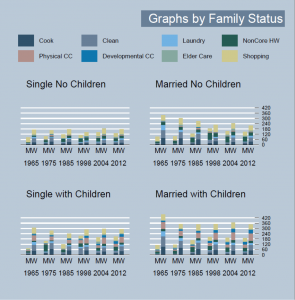
Closer inspection suggests that it is laundry and cleaning, more than cooking, that accounts for most of the differences in the amount of housework single men and women choose to do or not do. For example, in 2012, single women with no children report 13 minutes a day of laundry and 31 minutes cleaning. By contrast, single men report only seven and 17 minutes per day respectively in the same tasks.
Differences between single women and men with no children, and women and men who are married and/or parents follow similar lines. Married women without children and married mothers do about 20 minutes of laundry and about 45 minutes of daily cleaning. Comparable estimates for married men and fathers are less than five minutes in laundry and about 15 to 20 minutes of daily cleaning.
But does men’s lower time spent cleaning and doing laundry reflect the exercise of male power? Single women are certainly not cleaning and doing laundry to provide these services to partners, or to maintain a partner’s high(er) standards. Instead, the higher levels of laundry in particular point to gendered expectations about appearance and the myriad of ways femininity requires time devoted to maintaining the latest fashions, in clothing and household décor. It also underscores the ways that “doing gender” structures identities, as well as interactional dynamics in couples, social norms about femininity and masculinity, and institutions.
“Doing gender” structures identities.
In other words, some of the differences in men’s and women’s household activities may not stem from unfair interpersonal power dynamics but from entrenched individual and cultural beliefs about “essential” qualities of being a woman versus being a man. Many women and men may even have a vested interest in maintaining some distinctions in housework – and child care – because of the ways these reinforce their sense of gender identity.
On the other hand, some of the difference may come from larger gender inequities in earnings. Some housework has to be done, even by single individuals, to meet daily needs for food, clean clothes, and domestic hygiene. Some of this work can be outsourced by eating meals out, buying convenience foods, or using drycleaners. But outsourcing may be more difficult for single women reliant on wages still only averaging less than 80 cents for every dollar a single man earns.
Historically, analysis of the gendered division of labor has focused more on housework than child care. This fit with the 1950s ideology that good wives prioritized providing a “haven” for men, cosseting husbands after a hard day’s labor with a good meal, a clean house, a comfortable recliner, and happy children quickly tucked into bed after a hello and a hug from fathers. But analysis of housework alone is insufficient to understanding the complex picture of gender equality today. The influence of marriage on the gendered division of labor has waned.
Today parenthood is the role associated with a more gendered division of housework, even among couples with relatively egalitarian patterns before the birth of the child (Grunow, Schulz, and Blossfeld 2012). Studies that track women and men as they transition into marriage and parenthood indicate that newly married couples in first marriages share employment and housework relatively easily, but becoming a parent creates a more gendered division of labor. On average, fathers increase paid work time and decrease housework; mothers do the opposite.
Among parents, the ratio of women’s child care to men’s has declined, but less dramatically than the housework ratio, falling from 7.0 to 2.1 for everyday physical care of young children.
However, in this case, the partial convergence does not result from decreases in mothers’ time. Unlike the downward trend in women’s housework and the more modest uptick in men’s housework (which stalled in the mid-1980s), mothers and fathers have both steadily increased their time investments in daily and developmental child care since 1975.
Among mothers, child care time did decline significantly between 1965 and 1975, falling from one and half hours to less than one and a quarter hours. This time held steady until 1985, then rose to almost two hours in 2004 and 2012. Fathers’ child care was stable from 1965 to 1985, at about 20 minutes a day, but then increased by 41 minutes by 2012.
Moreover, fathers have not just increased their time in the more rewarding activities of developmental child care (e.g. teaching and playing with children) but also in the daily physical care of young children (feeding, bathing, soothing, and closely supervising them). In 1965, married fathers reported 11 minutes per day in daily physical care, and another 11 minutes in developmental care. By 2012, their daily care (the core work of childcare) had tripled to 34 minutes and their development care had doubled, to 25 minutes.
Married mothers are still doing more physical child care than married fathers, and the gap has remained stable at about 35 minutes. Meanwhile, mothers too have increased their developmental time (teaching and playing). This has more than quadrupled, from seven minutes in 1965 to 31 minutes a day in 2012, not significantly different than married fathers’ 25 minutes.
Mothers’ and fathers’ high levels of developmental child care time reflect new cultural norms of parenting that demand high investments of resources – time and money – in children. “Good” parents are those who prioritize children’s care and activities over their own needs and desires. Good parents are “experts” in children’s needs and developmental processes, and exercise intense, hands-on supervision of children’s whereabouts and activities. “Free range” children, meaning those who independently play outside or walk to activities, were relatively commonplace in the 1950s, but are remarkable enough today to result in visits from child protective services.
Child care remains a highly gendered activity. Again, this does not seem to stem primarily from fathers’ intransigent exercise of patriarchal power. Mothers are held accountable to standards of intensive parenting to a greater extent than fathers, but qualitative data suggest fathers today feel that children are entitled to men’s close attention and time (Daly 1996; Daly 2001) and fathers and mothers both report feeling they spend too little time with children (Milkie et al. 2010). In fact, studies suggest that some mothers may limit fathers’ involvement with children to maintain control over childrearing, a phenomenon referred to as maternal gatekeeping (Allen and Hawkins 1999; Schoppe-Sullivan et al. 2008).
Mothers are held accountable to standards of intensive parenting to a greater extent than fathers, but qualitative data suggest fathers today feel that children are entitled to men’s close attention and time, and fathers and mothers both report feeling they spend too little time with children.
Childrearing practices are influential mechanisms of class reproduction. The “concerted cultivation” model of parenting practiced by employed, married, middle-class parents requires that parents supervise children’s participation in extracurricular activities and devote many hours to developing children’s language and reasoning skills. These investments of time build children’s human and social capital and broad cultural competence. “Concerted cultivation” parenting is as much or more about parental anxiety over children’s economic futures as it is about perpetuating gender inequality, even if it does end up doing so. Today, ensuring that children are upwardly mobile is thought to require admission to and graduation from an elite college, because this improves children’s prospects of securing a middle-class job in times of heightened economic insecurity.
Support for this class-based interpretation can be found in the fact that parents with a college education do more child care compared to those without a college education, despite the fact that college-educated Americans are more likely to express support for equal sharing of paid work and child care. The positive influence of college on parents’ time in child care activities intensified between 1965 and 2012, with the gap between college-educated and non-college-educated parents’ child care time doubling over the period. In 1965, college-educated mothers reported about 20 more minutes in child care than mothers without a college education; in 2012, the difference was over 40 minutes a day. Among fathers, those with a college education did 16 more minutes of child care in 1965 and just under 30 minutes in 2012. Hence, the rate of positive increase in child care time is stronger among college educated parents. Because college increases mothers’ and fathers’ child care time, however, the gender gap in care remains similar when we compare college- and non-college-educated parents.
Conclusion.
Married men today are doing about one hour of household work and one hour of child care on top of their employment. Most married women are also doing at least a part-day second shift. And many women and men are raising children without a partner in the household. So all parents are working longer hours in paid work, housework, and child care, leaving less time for leisure and sleep. Parents report feeling more pulled between “work and family,” with little time for individual or couple time. Is this gender nirvana? Hardly. There is more opportunity for men and women to share the joys of family life, but also more pressure to share the stresses.
All parents are working longer hours in paid work, housework, and child care, leaving less time for leisure and sleep. Is this gender nirvana?
Taking advantage of the positive aspects of gender change requires substantial shifts in workplace cultures that valorize long work hours and primary allegiance to work over family. Getting fathers more involved in housework and child care is insufficient, and possibly impossible given the long work hours that are so common for college-educated professionals. And gender equality won’t come from mothers devoting less time to child care; indeed quantitative and qualitative data highlight how mothers protect child care time from other time demands. The best way to celebrate Mother’s Day and Father’s Day is by making it possible for all parents to stop being forced to choose between the rewards of caregiving and those of secure and supportive employment.
References
Allen, S.M. and A.J. Hawkins. 1999. “Maternal Gatekeeping: Mothers’ Beliefs and Behaviors That Inhibit Greater Father Involvement in Family Work.” Journal of Marriage and the Family 61:199-212.
Daly, K.J. 1996. “Spending Time With the Kids: Meanings of Family Time for Fathers.” Family Relations 45:466-476.
—–. 2001. “Deconstructing Family Time: From Ideology to Lived Experience.” Journal of Marriage and the Family 63:283-294.
Goode, W.J. 1992. “Why Men Resist.” Pp. 287-310 in Rethinking the Family: Some Feminist Questions, edited by B. Thorne and M. Yalom. Boston: Northeastern University Press.
Jackman, M. 1994. The Velvet Glove: Paternalism and Conflict in Gender, Class, and Race Relations. Vol.1. Berkeley, California: University of California Press.
Milkie, M.A., S.M. Kendig, K.M. Nomaguchi, and K.E. Denny. 2010. “Time With Children, Children’s Well-Being, and Work-Family Balance Among Employed Parents.” Journal of Marriage and Family 72:1329-1343.
Schoppe-Sullivan, S.J., G.L. Brown, E.A. Cannon, S.C. Mangelsdorf, and M.S. Sokolowski. 2008. “Maternal Gatekeeping, Coparenting Quality, and Fathering Behavior in Families With Infants.” Journal of Family Psychology 22:389.
Liana C. Sayer is a professor of sociology and the director of the Maryland Time Use Lab at the University of Maryland.











